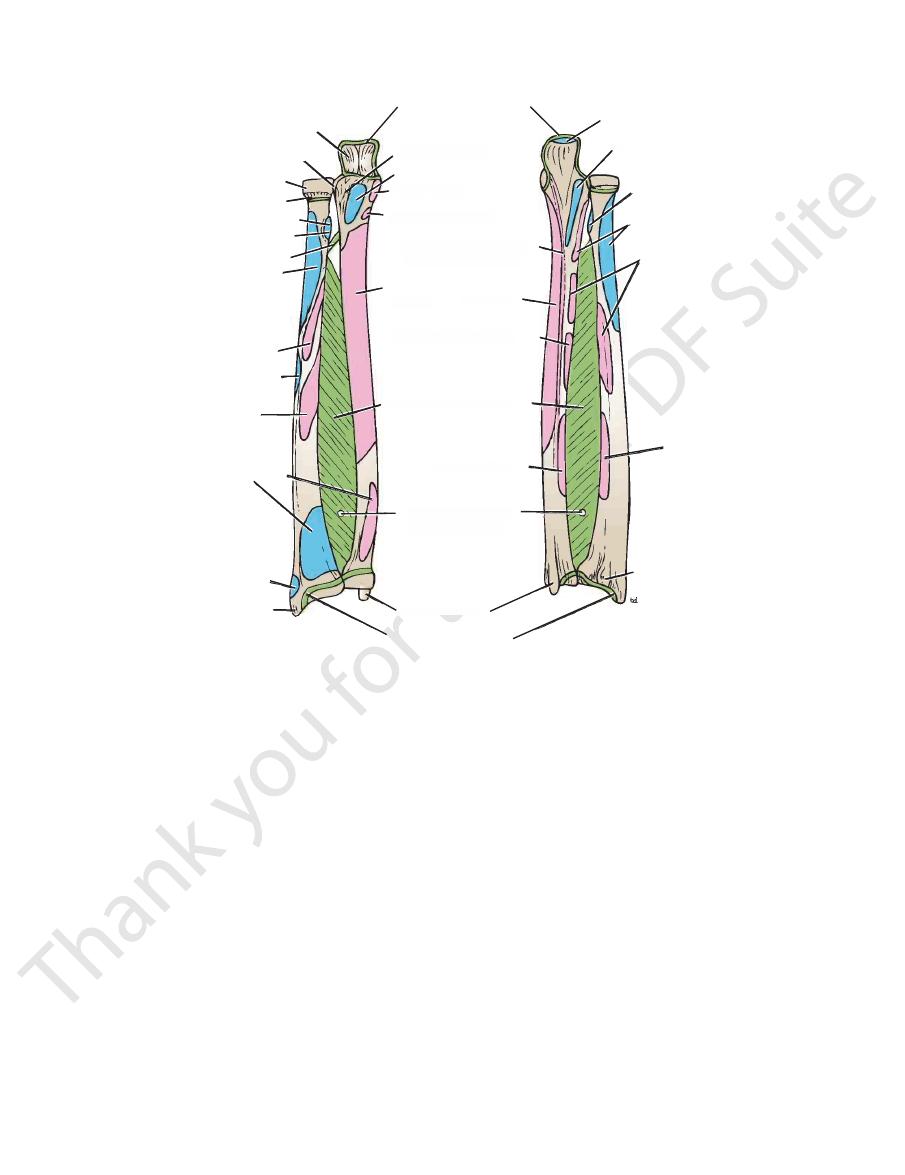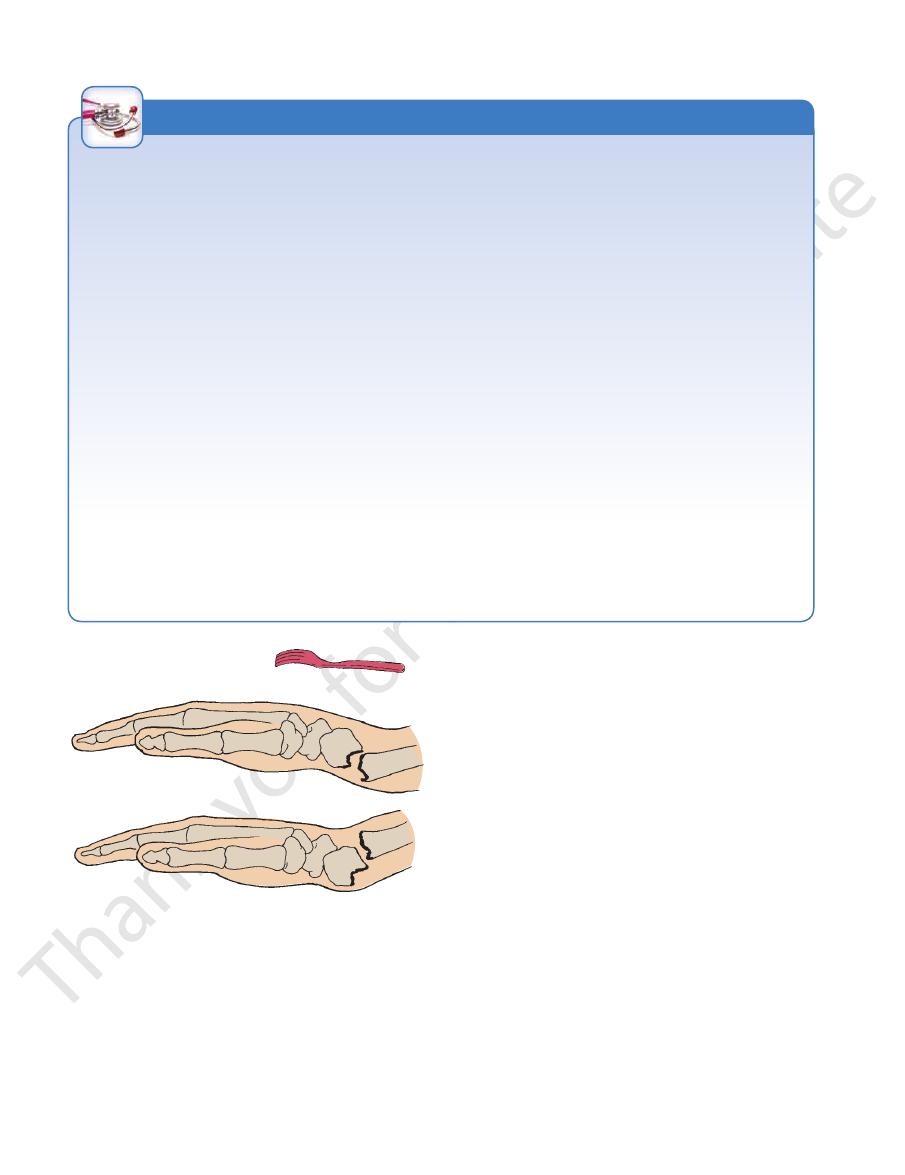
378
CHAPTER 9
The Upper Limb
ligament of the elbow joint. It continues downward to enter
of the fossa is formed by the supinator muscle
floor
The
drawn between the two epicondyles of the humerus.
of the triangle is formed by an imaginary line
The
The pronator teres muscle
Medially:
The brachioradialis muscle
Laterally:
of the elbow (Figs. 9.47 and 9.48).
The cubital fossa is a triangular depression that lies in front
elbow joint.
brachial artery and take part in the anastomosis around the
superior and inferior ulnar collateral arteries arise from the
The
Superior and Inferior Ulnar Collateral Arteries
sis around the elbow joint.
supplies the triceps muscle, and takes part in the anastomo
It accompanies the radial nerve through the spiral groove,
arises from the brachial artery near its origin (Fig. 9.45).
The profunda brachii artery
Profunda Brachii Artery
(Fig. 9.23).
The ulnar nerve has an articular branch to the elbow joint
Branches
carpi ulnaris (see page 390).
the forearm between the two heads of origin of the flexor
-
The Cubital Fossa
Boundaries
■
■
■
■
base
bicipital
aponeurosis
basilic vein
palmaris
longus
flexor
digitorum
superficialis
flexor carpi
ulnaris
pisiform
bone
biceps
brachii
biceps brachii tendon
cubital fossa
brachioradialis
cephalic vein
flexor carpi
radialis
site fo
palpati
of radi
artery
FIGURE 9.48
The cubital fossa and anterior surface of the
forearm in a 27-year-old man.
laterally and the brachialis muscle medially. The
joint and with the head of the radius at the proximal
proximal end articulates with the humerus at the elbow
The ulna is the medial bone of the forearm (Fig. 9.49). Its
radius are shown in Figure 9.49.
The important muscles and ligaments attached to the
of the extensor pollicis longus (Fig. 9.49).
which is grooved on its medial side by the tendon
tubercle,
dorsal
terior aspect of the distal end is a small tubercle, the
articulates with the scaphoid and lunate bones. On the pos
the round head of the ulna. The inferior articular surface
which articulates with
ulnar notch,
medial surface is the
projects distally from its lateral margin (Fig. 9.49). On the
styloid process;
At the distal end of the radius is the
its lateral side.
tion of the pronator teres muscle, lies halfway down on
for the inser
pronator tubercle,
and ulna together. The
ment of the interosseous membrane that binds the radius
medially for the attach
interosseous border
has a sharp
of the ulna, is wider below than above (Fig. 9.49). It
The shaft of the radius, in contradistinction to that
for the insertion of the biceps muscle.
bicipital tuberosity
Below the neck is the
neck.
to form the
notch of the ulna. Below the head, the bone is constricted
The circumference of the head articulates with the radial
and articulates with the convex capitulum of the humerus.
(Fig. 9.49). The upper surface of the head is concave
head
At the proximal end of the radius is the small circular
radioulnar joint.
of the hand at the wrist joint and with the ulna at the distal
distal end articulates with the scaphoid and lunate bones
joint and with the ulna at the proximal radioulnar joint. Its
Its proximal end articulates with the humerus at the elbow
The radius is the lateral bone of the forearm (Fig. 9.49).
The forearm contains two bones: the radius and the ulna.
nodes (Fig. 9.40).
pass up to the axilla and enter the lateral axillary group of
the medial side of the forearm. The efferent lymph vessels
fourth, and fifth fingers; the medial part of the hand; and
(Fig. 9.40). It receives afferent lymph vessels from the third,
fascia over the upper part of the fossa, above the trochlea
lies in the superficial
supratrochlear lymph node
The
and the radial nerve and its deep branch.
ulnar and radial arteries, the tendon of the biceps muscle,
median nerve, the bifurcation of the brachial artery into the
tures, enumerated from the medial to the lateral side: the
The cubital fossa (Fig. 9.47) contains the following struc
aponeurosis.
formed by skin and fascia and is reinforced by the bicipital
is
roof
Contents
-
Bones of the Forearm
Radius
-
-
this
-
Ulna

Basic Anatomy
379
radioulnar joint. Its distal end articulates with the radius at
bone, however, should be studied, because it is commonly
unnecessary. The position, shape, and size of the scaphoid
A detailed knowledge of the bones of the hand is
when all the bones are ossified.
ers begin to ossify at intervals thereafter until the 12th year,
capitate begins to ossify during the first year, and the oth
The bones of the hand are cartilaginous at birth. The
fingers.
passage of the median nerve and the flexor tendons of the
is formed for the
carpal tunnel,
osteofascial tunnel, the
In this manner, an
flexor retinaculum.
band called the
medial edges of which is attached a strong membranous
on their anterior surface a concavity, to the lateral and
bones. Together, the bones of the carpus present
hamate
and
trapezium, trapezoid, capitate,
eral to medial) the
consists of (from lat
distal row
bones. The
pisiform
scaphoid, lunate, triquetral,
(from lateral to medial) the
consists of
proximal row
four (Figs. 9.51 and 9.52). The
There are eight carpal bones, made up of two rows of
ulna are shown in Figure 9.49.
The important muscles and ligaments attached to the
cess (Fig. 9.49).
which has projecting from its medial aspect the styloid pro
head,
At the distal end of the ulna is the small rounded
muscle.
that gives origin to the supinator
supinator crest
palpated throughout its length. Below the radial notch
border is rounded and subcutaneous and can be easily
attachment of the interosseous membrane. The posterior
laterally for the
interosseous border
9.49). It has a sharp
of the ulna tapers from above down (Fig.
The
radius.
for articulation with the head of the
radial notch
which has on its lateral surface
coronoid process,
of the humerus. Below the trochlear notch is the trian
which articulates with the trochlea
trochlear notch,
nence of the elbow. It has a notch on its anterior surface,
(Fig. 9.49); this forms the promi
olecranon process
The proximal end of the ulna is large and is known as
joint by the articular disc.
the distal radioulnar joint, but it is excluded from the wrist
the
-
the
-
gular
the
shaft
is the
-
Bones of the Hand
and
-
-
fractured. The ridge of the trapezium and the hook of the
hamate should be examined.
olecranon process
radial notch of ulna
head
neck
bicipital tuberosity
biceps brachii
oblique cord
supinator
flexor digitorum
superficialis
pronator teres
flexor pollicis
longus
pronator quadratus
brachioradialis
styloid process
aperture for anterior
interosseous artery
extensor indicis
extensor pollicis longus
flexor
digitorum
profundus
aponeurosis for extensor
and flexor carpi ulnaris
flexor pollicis longus
pronator teres
brachialis
coronoid process
capsule of elbow joint
triceps
anconeus
biceps
supinator
abductor pollicis
longus
extensor pollicis
brevis
dorsal tubercle of
radius
anterior surface
posterior surface
interosseous membrane
capsule of wrist joint
styloid process
a
aperture for anterior
interosseous artery
extensor indicis
extensor pollicis longus
flexor
digitorum
profundus
aponeurosis for extensor
and flexor carpi ulnaris
flexor pollicis longus
pronator teres
brachialis
coronoid process
anc
interosseous membrane
styloid process
FIGURE 9.49
Important muscular and ligamentous attachments to the radius and the ulna.

380
CHAPTER 9
The Upper Limb
Fractures of the Radius and Ulna
A small subcutaneous bursa is present over the olecranon pro
Colles’ fracture because the distal fragment is displaced anteri
is a fracture of the distal end of the radius
Colles’ fracture
process can be produced by the pull of the triceps muscle. Good
the pull of the triceps muscle, which is inserted on the olecranon
the proximal third of the radius is fractured
Galeazzi’s fracture,
the shaft of the ulna is fractured by a force applied from behind.
supination, the normal anatomic relationship of the radius, ulna,
fragment of the radius is pronated and pulled medially by the
can occur from falls on the
Fractures of the head of the radius
outstretched hand. As the force is transmitted along the radius,
the head of the radius is driven sharply against the capitulum,
splitting or splintering the head (Fig. 9.10).
Fractures of the neck of the radius occur in young children
from falls on the outstretched hand (Fig. 9.10).
Fractures of the shafts of the radius and ulna may or may
not occur together (Fig. 9.10). Displacement of the fragments is
usually considerable and depends on the pull of the attached
muscles. The proximal fragment of the radius is supinated by the
supinator and the biceps brachii muscles (Fig. 9.10). The distal
pronator quadratus muscle. The strength of the brachioradialis
and extensor carpi radialis longus and brevis shortens and angu-
lates the forearm. In fractures of the ulna, the ulna angulates
posteriorly. To restore the normal movements of pronation and
and interosseous membrane must be regained.
A fracture of one forearm bone may be associated with a dis-
location of the other bone. In Monteggia’s fracture, for example,
There is a bowing forward of the ulnar shaft and an anterior dis-
location of the radial head with rupture of the anular ligament. In
and the distal end of the ulna is dislocated at the distal radioulnar
joint.
Fractures of the olecranon process can result from a fall on
the flexed elbow or from a direct blow. Depending on the loca-
tion of the fracture line, the bony fragment may be displaced by
process (Fig. 9.10). Avulsion fractures of part of the olecranon
functional return after any of these fractures depends on the
accurate anatomic reduction of the fragment.
resulting from a fall on the outstretched hand. It commonly
occurs in patients older than 50 years. The force drives the dis-
tal fragment posteriorly and superiorly, and the distal articular
surface is inclined posteriorly (Fig. 9.50). This posterior displace-
ment produces a posterior bump, sometimes referred to as the
“dinner-fork deformity” because the forearm and wrist resemble
the shape of that eating utensil. Failure to restore the distal artic-
ular surface to its normal position will severely limit the range of
flexion of the wrist joint.
Smith’s fracture is a fracture of the distal end of the radius
and occurs from a fall on the back of the hand. It is a reversed
-
orly (Fig. 9.50).
Olecranon Bursitis
-
cess of the ulna, and repeated trauma often produces chronic
bursitis.
C L I N I C A L N O T E S
A
B
FIGURE 9.50
Fractures of the distal end of the radius.
of the medial cutaneous nerve of the forearm (Fig. 9.38).
neous nerve, and from the anterior and posterior branches
nerve of the forearm, a continuation of the musculocuta
the anterior and posterior branches of the lateral cutaneous
to the skin of the forearm is from
sensory nerve supply
The
hand and fingers are shown in Figures 9.51 and 9.52.
The important muscles attached to the bones of the
only two for the thumb.
There are three phalanges for each of the fingers but
surfaces are posterior, lateral, and medial.
concave forward and is triangular in transverse section. Its
and 9.52). The shaft of each metacarpal bone is slightly
knuckles, articulate with the proximal phalanges (Figs. 9.51
distal row of the carpal bones; the heads, which form the
The bases of the metacarpal bones articulate with the
surface is directed laterally and not backward.
rotated medially through a right angle so that its extensor
the others but occupies a more anterior position. It is also
est and most mobile. It does not lie in the same plane as
The first metacarpal bone of the thumb is the short
(Figs. 9.51 and 9.52).
head
There are five metacarpal bones, each of which has a
Smith’s fracture.
Colles’ fracture.
A.
B.
The Metacarpals and Phalanges
base,
a shaft, and a
-
The Forearm
Skin
-
A narrow strip of skin down the middle of the
ior
poster
surface of the forearm is supplied by the posterior cutaneous
lateral side of the dorsal venous arch on the back of the
arises from the
cephalic vein
ficial fascia (Fig. 9.39). The
of the forearm lie in the super
superficial veins
The
nerve of the forearm.
-
